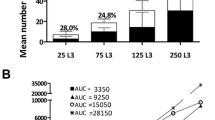Summary
In order to elicit primary intestinal histoplasmosis, hamsters and mice were given the infective agent by drinking a suspension of yeast cells, eating infected mouse liver, and through injection into the wall of the lumen of the cecum after laparotomy.
Histologic examination and isolation by cultures were made, maximally 6 weeks after infection.
No clear-cut histoplasmic primary complex in the intestine was confirmed, but a fungus disease was achieved in a few animals, suggesting the intestinal tract as a possible portal of entrance of the infection.
Some of the animals fed with a fungus suspension developed primary pulmonary lesions, a remarkable fact to be considered in evaluation of ‘feeding’ experiments.
The lack of confirmed evidence of intestinal primary lesions as contrasted with the constant demonstration, when searched for, of pulmonary lesions, would suggest that the intestinal tract should not be considered a major portal of entrance in histoplasmosis.
Similar content being viewed by others
References
Schulz, D. M. 1954. Histoplasmosis. A statistical morphologic study. Amer. J. clin. Path.24: 11–26.
Rubin, H., Furcolow, M. L., Yates, J. L. &Brasher, C. A. 1959/1960. The course and prognosis of histoplasmosis. Amer. J. Med. Seminar on Mycotic Infections. 27 & 28: 19.
Schwarz, J., Bingham, E. &Roubenoff, D. 1955. The communicability of experimentally induced histoplasmosis. Amer. J. clin. Path.25: 932–934.
De Monbreun, W. A. 1939. The dog as a natural host forHistoplasma capsulatum. Amer. J. trop. Med.19: 565–587.
Allen, R. M. 1948. Experimental histoplasmosis. Portal of Entry of the Fungus. Amer. J. trop. Med.28: 85–89.
Farrel, R. L., Cole, C. R. Prior, J. A. &Saslaw, S. 1953. Experimental histoplasmosis. I. Methods for production of histoplasmosis in dogs. Proc. Soc. exp. Biol. Med.84: 51–54.
Grayston, J. T., Altman, P. L. &Cozad, G. C. 1956. A preliminary report. Publ. Health Monogr.39: 99.
Procknow, J. J. 1960 The pathogenesis of histoplasmosis in animals.H. Sweany, Histoplasmosis. Charles C. Thomas, Springfield, Ill.
Robinson, V. &McVickar, D. L. 1952. Pathology of spontaneous canine histoplasmosis. A study of twenty-one cases. Amer. J. vet. Res.13: 214–219.
Emmons, C. W. 1950. Histoplasmosis: Animal reservoirs and other sources in nature of the pathogenetic fungusHistoplasma. Amer. J. Publ. Health40: 436–440.
Emmons, C. W., Binford, C. H. &Utz, J. P. 1963. Medical Mycology. Lea and Febiger, Philadelphia, p. 220.
Prior, J. A. &Cole, C. R. 1951. Studies on the communicability of histoplasmosis. Amer. Rev. Tuberc.63: 538–546.
Author information
Authors and Affiliations
Additional information
This project was supported in part by Grant 986 from the National Institutes of Health.
Rights and permissions
About this article
Cite this article
Salfelder, K., Sethi, K.K. Experimental intestinal histoplasmosis of hamsters. Mycopathologia et Mycologia Applicata 32, 153–162 (1967). https://doi.org/10.1007/BF02049630
Issue Date:
DOI: https://doi.org/10.1007/BF02049630




